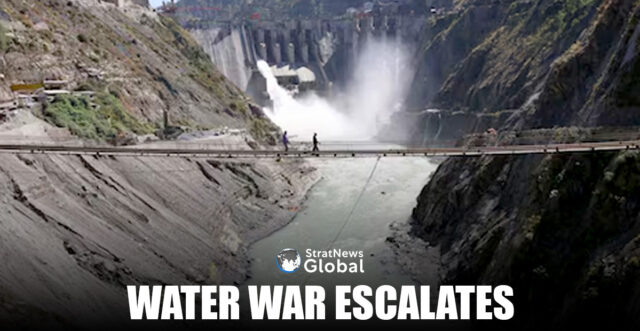India has started reservoir capacity expansion at two hydroelectric projects in Jammu and Kashmir following renewed tensions with Pakistan that prompted the suspension of a water-sharing agreement, according to sources.
The work represents the first tangible step by India to operate outside agreements covered by the Indus Waters Treaty, unbroken since 1960 despite three wars and several other conflicts between the nuclear-armed rivals.
Indus Waters Treaty Suspension
Last month, however, New Delhi suspended the pact that ensures supply to 80% of Pakistani farms after a terrorist attack in Jammu and Kashmir’s Pahalgam killed 26, and it identified two of the three assailants as Pakistani nationals.
Islamabad has threatened international legal action over the suspension and denied any role in the attack, warning, “Any attempt to stop or divert the flow of water belonging to Pakistan … will be considered as an act of war”.
India ‘Flushes’ Reservoirs
A “reservoir flushing” process to remove sediment began on Thursday, carried out by India’s biggest hydropower company, state-run NHPC Ltd and authorities in the federal territory of Jammu and Kashmir, the three sources said.
Flushing is a method used to clear accumulated silt and sediment from a reservoir or dam by releasing a high volume of water, which carries the sediment downstream.
A senior government official confirmed that the process had commenced at the 900 MW Baglihar plant in Ramban district and the 690 MW Salal plant in Reasi district.
The work may not immediately threaten supply to Pakistan, which depends on rivers flowing through India for much of its irrigation and hydropower, but it could eventually be affected if other projects launch similar efforts.
There are more than half a dozen such projects in the region.
India Proceeds ‘Without Notification’
India did not inform Pakistan about the work at the Salal and Baglihar projects, which is being done for the first time since they were built in 1987 and 2008/09, respectively, as the treaty had blocked such work, the sources added.
They spoke on condition of anonymity as they were not authorised to talk to the media.
India’s NHPC and the neighbouring governments did not reply to emails from Reuters to seek comment.
Since independence from British colonial rule in 1947, India and Pakistan have fought two of their three wars over Kashmir, in addition to numerous short conflicts.
The flushing operation ran for three days from May 1, the sources said.
“This is the first time such an exercise has taken place and will help in more efficient power generation and prevent damage to turbines,” one of the sources told Reuters.
“We were also asked to open the adjustable gates for cleaning, which we did from May 1,” the source said, adding that the effort aimed to free dam operation from any restrictions.
People living on the banks of the Chenab River on the side of Jammu and Kashmir said they noticed water had been released from both Salal and Baglihar dams from Thursday to Saturday.
‘Free Will’
The flushing of hydropower projects requires nearly emptying a reservoir to force out sediments whose build-up is a major cause of decline in output.
For example, two of the sources said that power delivered by the 690-MegaWatt Salal project was far below its capacity, because Pakistan had prevented such flushing, while silting also hit output at the 900-MW Baglihar project.
“Flushing is not a common thing because it leads to a lot of water wastage,” said one of the sources. “Downstream countries are expected to be informed in case it leads to any inundation.”
Building both projects had required extensive back and forth with Pakistan, which worries about losing out on its share of water.
Under the 1960 treaty, which split the Indus and its tributaries between the neighbours, India had also shared data such as hydrological flows at various spots on the rivers flowing through India and issued flood warnings.
India’s water minister has vowed to “ensure no drop of the Indus river’s water reaches Pakistan”.
Government officials and experts on both sides say India cannot stop water flows immediately, however, as the treaty has allowed it only to build hydropower plants without significant storage dams on the three rivers allocated to Pakistan.
The suspension means India “can now pursue our projects at free will”, said Kushvinder Vohra, a recently retired head of India’s Central Water Commission who worked extensively on Indus disputes with Pakistan.
Prime Minister Narendra Modi’s government has sought to renegotiate the treaty in recent years, and the archfoes have tried to settle some of their differences at the Permanent Court of Arbitration in the Hague.
These concerns relate to the size of the water storage area at the region’s Kishenganga and Ratle hydroelectric plants.
(With inputs from Reuters)





